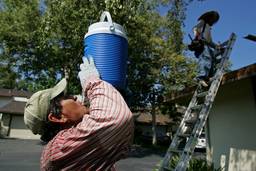Will Bayer Get the Drift on Dicamba?
The agrochemical company has been ordered to pay hundreds of millions of dollars in lawsuits alleging its potent herbicide drifts and damages crops.
Dave Dickey Midwest Center for Investigative Reporting

Any day now Bayer AG will probably be trumpeting its newest, shiny, fan-dangled formulation of XtendiMax dicamba herbicide (with VaporGrip technology?) for the 2021 growing season. Bayer will say things like “We are proud of our role in bringing innovations like XtendiMax to give growers the tools they need to safely, successfully, and sustainably protect their crops from weeds (cross our hearts and hope to die).”
But anyone paying attention has learned that Bayer’s record on dicamba, a herbicide used to kill weeds, has been less than stellar, if not downright ugly.
After the U.S. Court of Appeals for the Ninth Circuit issued an order vacating EPA’s 2018 registration of over-the-top dicamba products for soybeans and cotton, Bayer has tried to short-circuit potential lawsuits from producers suffering crop damage. In June Bayer announced a $300 million dicamba settlement to pay cotton and soybean farmers who could prove yield losses due to dicamba from 2015 through this growing season. Bayer also tossed another $100 million in to settle other dicamba damage claims.
Certainly Bayer doesn’t want to be put through the dicamba wringer if it can help it. Bayer is currently appealing afederal jury verdict in Cape Girardeau, Missouri that awarded peach-growing Bader Farms a staggering $265 million payout in damages and penalties for dicamba drift.
Okay. There’s going to be lots of questions from farmers and concerned environmental groups surrounding Bayer’s new dicamba formulation.
As the courts have revealed Monsanto — which Bayer purchased — really didn’t offer up much independent scientific study to EPA to prove its claim that its dicamba formulation didn’t drift from where it was sprayed. The Ninth Circuit Court of Appeals wrote:
“The EPA made multiple errors in granting the conditional registrations…. The EPA substantially understated the risks it acknowledged, and it entirely failed to acknowledge other risks. We conclude that the ‘fundamental flaws’ in the EPA’s analysis are so substantial that it is exceedingly ‘unlikely that the same rule would be adopted on remand.’ ”
It was only after EPA approved Monsanto’s original 2016 request for registration that a university’s independent study as well as actual usage revealed the truth: Dicamba did not work as Monsanto promised.
When Bayer purchased Monsanto in 2016, little did the company know about the litigation hot mess that was waiting. And now it’s Bayer that has to show EPA it can deliver a dicamba formulation that will not drift or minimally drift. And everyone will be watching how the process plays out. Closely.
You see, Monsanto was probably playing the long game when it came to its dicamba roll out. Recall that Monsanto sold dicamba-resistant seeds in the 2016 growing season without its accompanying dicamba formulation. It was in the 2017 growing season that Monsanto introduced XtendiMax dicamba herbicide. Why is that? Because Monsanto knew XtendiMax drifted, but if the company could reach critical market share, dicamba drift would not matter very much for row crops.
For this growing season, Bayer estimated Xtend soybean plantings at 50 million acres — about 66% of 2019 plantings. And there’s the problem: Bayer had similar dicamba seed plantings in 2019. It’s flat lined. And nipping at its heels is Corteva, which this growing season offered its own herbicide resistant soybean seed and accompanying weed killer. Corteva estimates that its Enlist E3 seed will account for about 20% of the U.S. market. Farmers are flocking to Corteva because they don’t want the hassles of dealing with Bayer’s XtendiMax and the complicated, almost impossible to follow spraying requirements laid out by the EPA.
Bayer says new formulations of dicamba are now at EPA and the company expects to make announcements this fall. But given Monsanto’s shenanigans it could very well be that the EPA’s registration process will not be open and above board.
The recent EPA registration approval of BASF’s herbicide isoxaflutole for soybeans provides a cautionary tale. That’s because EPA completely bypassed the normal process of requesting public comment for isoxaflutole in the Federal Register. The only people that knew of EPA’s 30 day public comment period in January were folks wanting to get the registration approved — all 54 comments.
And then to add insult to the injury, EPA’s assistant administrator for the chemical safety division, Alexandra Dapolito Dunn, announced that “we listened and believe this action balances the need to provide growers with the products necessary to continue to provide Americans with a safe and abundant food supply while ensuring our country’s endangered species are protected.” So much for transparency.
Further complicating Bayer’s dicamba woes is growing suspicion from weed scientists that weeds are developing resistance to the herbicide.
Bayer had planned to build a $1 billion (yeah, bbbbbilllion) dicamba plant in Luling, Louisiana. Those plans have been scrapped due to what Bayer says are cash-flow problems (all this litigation is expensive), and has nothing to do with the company’s confidence of delivering a dicamba formulation that doesn’t drift. Your mileage may vary on that particular statement.
At this point I expect there’s little confidence from anyone paying attention — farmers, scientists, environmental groups — that Bayer will fix its dicamba problems next growing season. Bayer and the out-to-lunch EPA enablers will certainly register some dicamba formulation for 2021. But Monsanto/Bayer missteps have destroyed much of the public’s trust. Only a completely transparent, open registration process with independent research is now acceptable.
Editor’s Note: The Midwest Center for Investigative Reporting is a nonprofit, online newsroom offering investigative and enterprise coverage of agribusiness, Big Ag and related issues through data analysis, visualizations, in-depth reports and interactive web tools. Visit us online at www.investigatemidwest.org
Dave Dickey spent nearly 30 years at University of Illinois at Urbana-Champaign’s NPR member station WILL-AM 580 where he won a dozen Associated Press awards for his reporting. For 13 years, he directed Illinois Public Media’s agriculture programming. His weekly column for the Midwest Center covers agriculture and related issues including politics, government, environment and labor.





